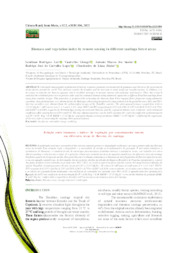Biomass and vegetation index by remote sensing in different caatinga forest areas.
Biomass and vegetation index by remote sensing in different caatinga forest areas.
Author(s): LUZ, L. R.; GIONGO, V.; SANTOS, A. M. dos; LOPES, R. J. de C.; LIMA JÚNIOR, C. de
Summary: Continued unsustainable exploitation of natural resources promotes environmental degradation and threatens the preservation of dry forests around the world. This situation exposes the fragility and the necessity to study landscape transformations. In addition, it is necessary to consider the biomass quantity and to establish strategies to monitor natural and anthropic disturbances. Thus, this research analyzed the relationship between vegetation index and the estimated biomass using allometric equations in different Brazilian caatinga forest areas from satellite images. This procedure is performed by estimating the biomass from 9 dry tropical forest fragments using allometric equations. Area delimitations were obtained from the Embrapa collection of dendrometric data collected in the period between 2011 and 2012. Spectral variables were obtained from the orthorectified images of the RapidEye satellite. The aboveground biomass ranged from 6.88 to 123.82 Mg.ha-1. SAVI values were L = 1 and L = 0.5, while NDVI and EVI ranged from 0.1835 to 0.4294, 0.2197 to 0.5019, 0.3622 to 0.7584, and 0.0987 to 0.3169, respectively. Relationships among the estimated biomass and the vegetation indexes were moderate, with correlation coefficients (Rs) varying between 0.64 and 0.58. The best adjusted equation was the SAVI equation, for which the coefficient of determination was R2 = 0.50, R2 aj = 0.49, RMSE = 17.18 Mg.ha-1 and mean absolute error of prediction (MAE) = 14.07 Mg.ha-1, confirming the importance of the Savi index in estimating the caatinga aboveground biomass.
Publication year: 2022
Types of publication: Journal article
Unit: Embrapa Semi-arid Region
Observation
Some of Embrapa's publications are published as ePub files. To read them, use or download one of the following free software options to your computer or mobile device. Android: Google Play Books; IOS: iBooks; Windows and Linux: Calibre.
Access other publications
Access the Agricultural Research Database (BDPA) to consult Embrapa's full library collection and records.
Visit Embrapa Bookstore to purchase books and other publications sold by Embrapa.

